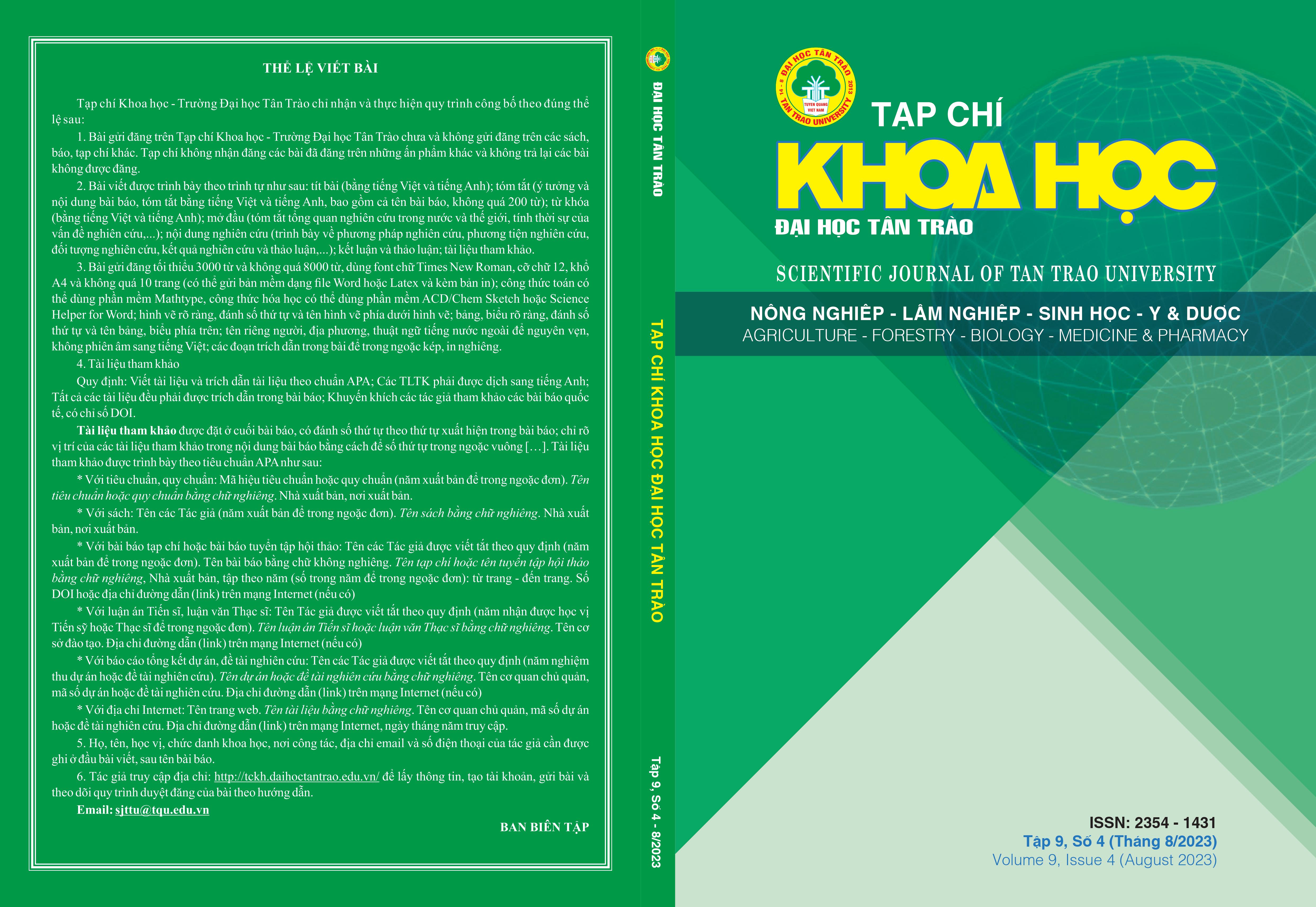EVALUATION OF THE CURCUMIN RELEASE OF CHITOSAN COATED NANOLIPOSOMES CONTAINING CURCUMIN USING FOR ORAL ADMINISTRATION
DOI:
https://doi.org/10.51453/2354-1431/2023/936Keywords:
Chitosan, curcumin, nanoliposomes, oral administration, releaseAbstract
Curcumin (Cur) has the potential to aid in the treatment of many diseases, but limited in efficacy because of its very low bioavailability. Cur is poorly absorbed, metabolized quickly and is excluded from the circulatory system. Preparation of nanoliposomes containing Cur (Lip-Cur) is a solution to improve oral bioavailability. Objective: This study aimed to prepare and evaluate the Cur release of chitosan coated nanoliposomes containing Cur (Chi-Lip-Cur) for oral adminstration. Methods: Nanosystems (Lip-Cur or Chi-Lip-Cur) were successfully prepared by thin film hydration method. Results: Cur release rate of Lip-Cur or Chi-Lip-Cur is fast in the first 30 minutes and later slow. Cur release from Lip-Cur last up to 6 hours, while Chi-Lip-Cur last up to 12 hours. Cur is released from Chi-Lip-Cur at a slower rate than Lip-Cur. Cur is released from Lip-Cur or Chi-Lip-Cur reached the highest value of pH 6.8 and lowest at pH 2.0. Conclusion: The results suggested that Chi-Lip-Cur has been successfully formulated to create an extended-release Cur delivery system for oral administration.
Downloads
References
[1] Takahashi, M., Uechi, S., Takara, K., Asikin, Y., Wada, K. (2009). Evaluation of an oral carrier system in rats: bioavailability and antioxidant properties of liposome-encapsulated curcumin. J. Agric. Food Chem., 57(19), 9141-9146. doi: 10.1021/jf9013923.
[2] Li, W., Xing, W., Niu, X., Zhou, P., Fan, T. (2013). The pharmacokinetics of chelerythrine solution and chelerythrine liposomes after oral administration to rats. Planta Med., 79(8), 654-660. doi: 10.1055/s-0032-1328540.
[3] Feng, T., Wei, Y., Lee, R. J., Zhao, L. (2017). Liposomal curcumin and its application in cancer. Int J Nanomedicine, 12, 6027-6044. doi: 10.2147/IJN.S132434.
[4] Zhou, W., Cheng, C., Ma, L., Zou, L., Liu, W., Li, R., Cao, Y., Liu, Y., Ruan, R., Li, J. (2021). The formation of chitosan-coated rhamnolipid liposomes containing curcumin: Stability and in vitro digestion. Molecules, 26(3), 560-573. doi: 10.3390/molecules26030560.
[5] Cheng, C., Peng, S., Li, Z., Zou, L., Liua, W., Liu, C. (2017). Improved bioavailability of curcumin in liposomes prepared using a pH-driven, organic solvent-free, easily scalable process. RSC Adv., 7, 25978–25986. doi.org/10.1039/C7RA02861J.
[6] Chen, W., Kuo, Y., Chen, C., Wu, H., Chen, H., Fang, W. (2022). Improving the stability and bioactivity of curcumin using chitosan-coated liposomes through a combination mode of high-pressure processing. LWT, 168 , 113946-113955. doi.org/10.1016/j.lwt.2022.113946.
[7] Nguyen, T. X., Huang, L., Gauthier, M., Yang, G., Wang, Q. (2016). Recent advances in liposome surface modification for oral drug delivery. Nanomedicine (Lond), 11(9), 1169-1185. doi: 10.2217/nnm.16.9.
[8] Nguyen, T. X., Huang, L., Liu, L., Abdalla, A. M. E., Gauthier, M., Yang, G. (2014). Chitosan-coated nano-liposomes for the oral delivery of berberine hydrochloride. J. Mater. Chem. B, 2(41), 7149-7159. doi: 10.1039/c4tb00876f.
Downloads
Published
How to Cite
Issue
Section
License

This work is licensed under a Creative Commons Attribution-ShareAlike 4.0 International License.
All articles published in SJTTU are licensed under a Creative Commons Attribution-ShareAlike 4.0 International (CC BY-SA) license. This means anyone is free to copy, transform, or redistribute articles for any lawful purpose in any medium, provided they give appropriate attribution to the original author(s) and SJTTU, link to the license, indicate if changes were made, and redistribute any derivative work under the same license.
Copyright on articles is retained by the respective author(s), without restrictions. A non-exclusive license is granted to SJTTU to publish the article and identify itself as its original publisher, along with the commercial right to include the article in a hardcopy issue for sale to libraries and individuals.
Although the conditions of the CC BY-SA license don't apply to authors (as the copyright holder of your article, you have no restrictions on your rights), by submitting to SJTTU, authors recognize the rights of readers, and must grant any third party the right to use their article to the extent provided by the license.


